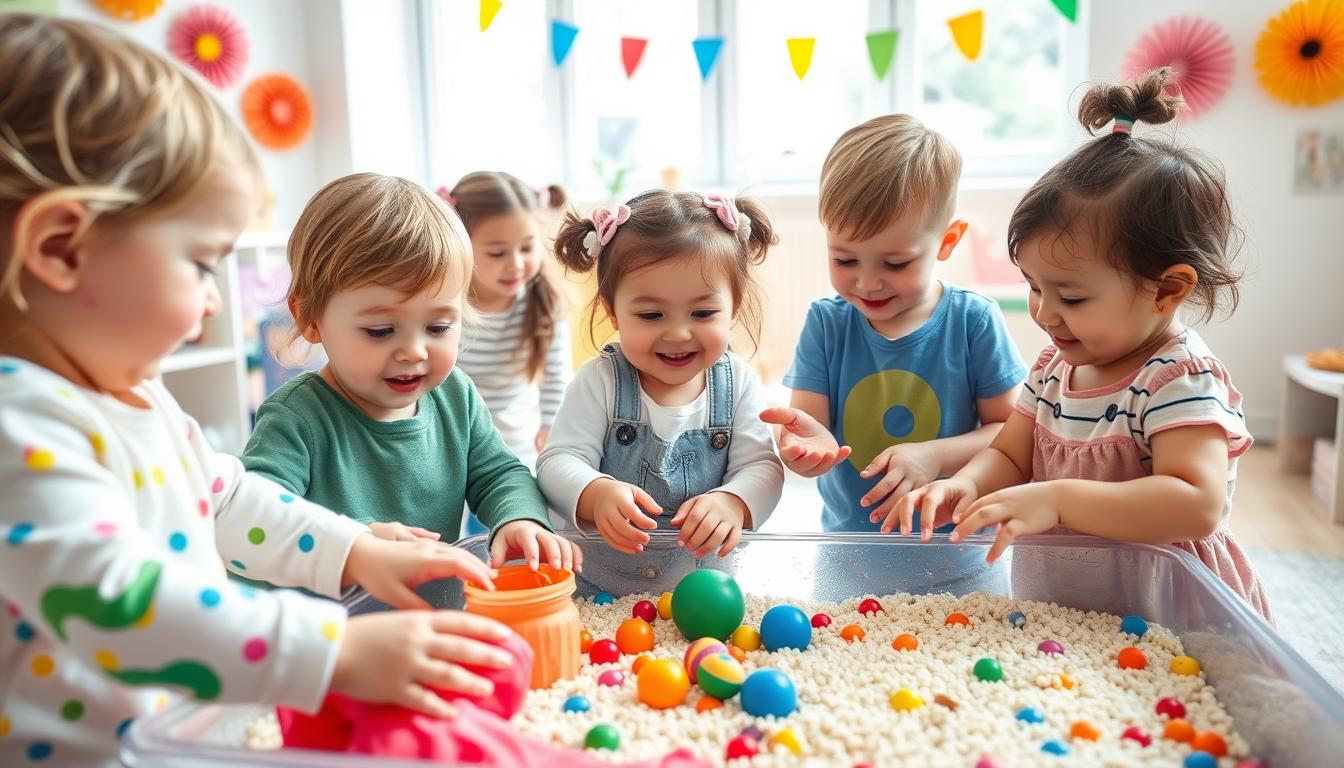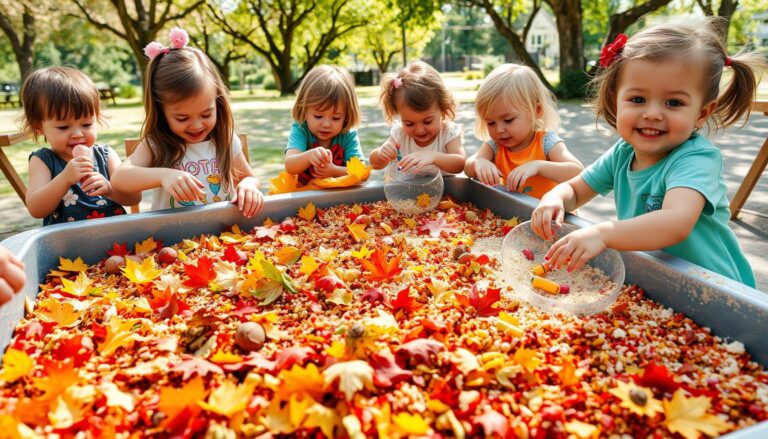Imagine it’s a chilly winter afternoon, and snowflakes are dancing outside. You and your little one are indoors, looking for something fun to do. Suddenly, you get the idea to make a sensory bin using items like rice, pasta, and food coloring. This simple activity brings big smiles and laughter to your child’s face. As they dig their hands into the colorful rice, their excitement is infectious. Through their giggles and curious exploration, you see how sensory play is so powerful for young kids.
Sensory activities are key for babies and toddlers because they help with their growth. They’re not just fun; they play a big part in developing their brains. In this article, we’re excited to share 20 sensory play ideas. These activities are great for home and they’re both educational and enjoyable. They’re sure to bring lots of happy, learning moments into your day!
Key Takeaways
- Sensory play is associated with enhancing creativity and scientific thinking in children.
- Engaging in sensory activities can stimulate all five senses: sight, sound, touch, taste, and smell.
- The incorporation of various materials, such as flour, water, and colored sand, plays a key role in the engagement of toddlers in sensory learning.
- Sensory activities can also support fine motor skills development, requiring hand-eye coordination and manipulation.
- Research shows that sensory play activities foster cognitive growth, necessary for problem-solving and abstract thinking skills.
- Outdoor sensory activities, such as listening to nature, are simple yet effective, promoting mindfulness and awareness in young children.
- Engaging children in sensory play through music (e.g., homemade drums) can enhance their rhythmic and melodic skills, crucial for cognitive development.
Why Sensory Play is Important for Babies and Toddlers
Sensory play is crucial for the growth of babies and toddlers. It helps with their brain development, learning how to talk, and moving around. It also boosts their social skills and emotional strength.
Benefits of Sensory Play
Sensory activities help children’s brains grow. They learn new words and how to express themselves. These activities are fun and teach important skills like holding and moving things carefully.
Activities like building or pouring improve little muscle movements. Running and jumping get better with practice, thanks to sensory play. It can also calm kids down, which is great for learning to focus. Playing together helps kids learn to talk and share, building friendships.
Developmental Milestones Supported by Sensory Activities
Sensory play supports big steps in learning and growth. It sharpens thinking and problem-solving. Sensory bins are great for exploring and understanding new things. They make the brain stronger, helping with thinking and learning.
Babies start exploring food by touching and tasting around 4 to 6 months. Finger painting lets them learn about different textures in a fun way. Playing outside, like in a sandbox, helps them learn more and grow healthy.
Bath time with bubbles and toys is fun and teaches about touch. Making music with everyday items improves speech, feelings, and body movement. Using things from around the house for play keeps it simple and creative.
Winter Indoor Toddler Activities to Stimulate Senses
Winter can make it tough for toddlers to play outside due to the cold. Yet, these winter indoor toddler activities are great for engaging their senses and keeping them entertained. You’ll find ideas for sensory bins with a winter theme, and tips for simple winter art projects below.
Creating a Sensory Bin with Winter Themes
Sensory bins let toddlers explore various textures, sounds, and sights. Take the Hot Chocolate Sensory Bin, which uses 7 cups of flour, 3 cups of cocoa powder, and, if you like, 2 cups of oil to create a cloud dough. These bins, good for winter theme ideas for preschool, can entertain kids for quite a while.

Another sensory bin idea involves making fake snow. Just mix 1 cup of conditioner with 4 cups of baking soda. It feels just like snow. These winter activities for one year olds improve skills such as grasping and digging. They also help toddlers learn new words as they describe what they find.
Simple Winter Art for Toddlers
Winter art for toddlers simple projects are great for stimulating their senses. Painting with ice cubes made from colored water is fun. As the ice melts on paper, your toddler creates art. This activity boosts their creativity and sensory skills.
To get more hands-on, try making snowflake stamps from foam sheets and wooden blocks. Toddlers will love stamping snowy scenes on dark paper, ideal for snow day toddler activities. Projects like these are super fun and encourage kids to explore different materials.
Infant Sensory Activities for Everyday Play
Playtime filled with various sensory materials is key for babies’ learning. It helps their senses and thinking skills grow. Here are two fun and easy ways to make your baby’s playtime better.
Black and White Shapes
Showing black and white patterns to your infant is great for their attention. They help babies remember things better and support brain growth. You can make these patterns at home or buy them.
Such activities are important for improving how well babies can follow movements with their eyes. They set up a solid base for learning more complex skills later.
Exploring Textures with Chiffon Scarves
Feeling different materials is also a good sensory play. Soft, colorful chiffon scarves offer many new feelings. When you lightly cover your baby’s hands and feet with the scarves, they learn about softness and smoothness.
This kind of play doesn’t just help with touching. It also helps babies learn to move and reach better. As they grab and pull the scarves, they are learning.
Adding these sensory activities for infants to daily play helps with baby sensory development. It’s all about keeping things simple and regular. This way, every day is a new chance to learn through play.
Winter Weather Toddler Activities for Sensory Exploration
Winter is a great time for indoor sensory activities. Winter weather toddler activities are fun and boost fine motor skills and creativity. Here are a few ideas to inspire you.
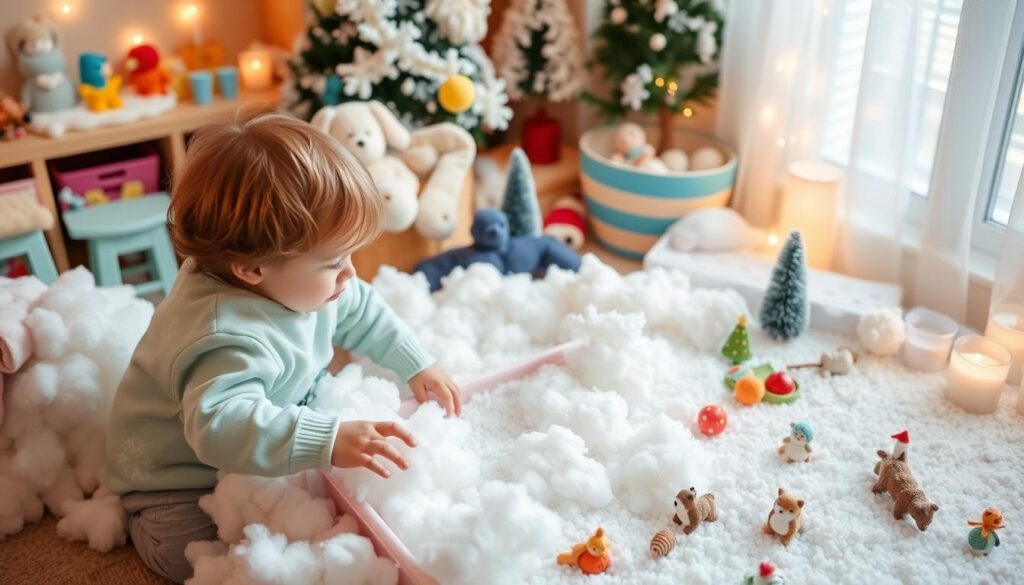
Snow Day Sensory Play
Bring the outdoor fun inside with snow day toddler activities. Create a sensory bin with either real or fake snow. Add things like pinecones, small toys, and kitchen tools. It’s perfect for tactile play and keeps kids busy for hours.
Add excitement with a homemade snowball launcher. Use rubber bands and plastic cups for this. It’s a way to join in as a family and learn some physics. Building snow forts or making snowy art are awesome ideas too!
Edible Snow Dough
Try making edible snow dough for another winter weather toddler activity. It’s safe for kids who like to taste everything. Mix baking soda with shaving foam to get snow-like dough. A bit of vanilla extract makes it smell nice!
Let older kids help make and shape the dough. This project is great for sensory play and learning basic chemistry. It’s perfect for creative play and teaching about material changes.
These snow ideas for kids will make any cold day enjoyable and educational. With these activities, winter instantly becomes a time for fun and learning.
Sensory Play Ideas Using Edible and Taste-Safe Materials
Using edible materials for sensory bins is safe for toddlers, especially those who like to explore with their mouths. These ideas are safe and stimulate the senses. They give parents peace of mind and offer kids fun, sensory-rich activities.
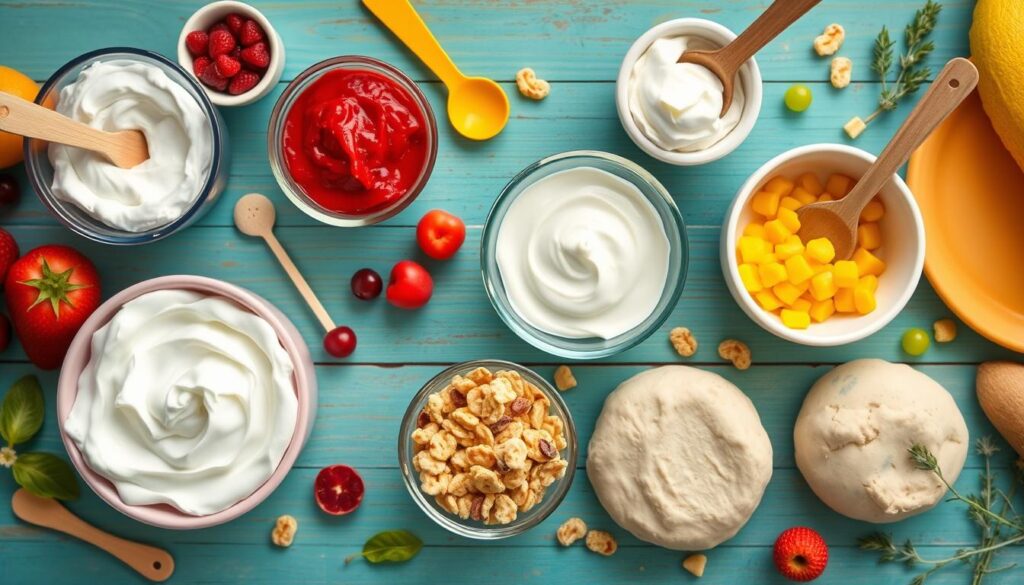
Edible sensory play helps children grow their motor skills, language, and emotions. With recipes using things from around the house, setting up safe, fun activities is easy.
Edible Oat Sensory Bin
Make an edible oat sensory bin to introduce new textures. Fill a bin with oats and add scoops, cups, or safe toys. This mix of touch and play keeps them busy for a while.
- Use rolled oats as the base.
- Add scoops and cups for pouring.
- Include small, taste-safe toys for added interest.
Tapioca Pearls as Edible Water Beads
Using *tapioca pearls* as edible water beads is another cool idea. They’re squishy, safe for kids, and fun to play with. They’re a better choice than non-edible beads.
- Cook tapioca pearls as the package says.
- Cool them down before adding to a sensory bin.
- Put in spoons and bowls for scooping and playing.
*Taste-safe sensory play* is growing popular, offering safe exploration options. From oats to tapioca pearls, these edible play ideas get lots of love from parents. They’ve been shared 1.0K times online, showing that many find these activities both useful and fun.
Creating Sensory Bins for Babies and Toddlers
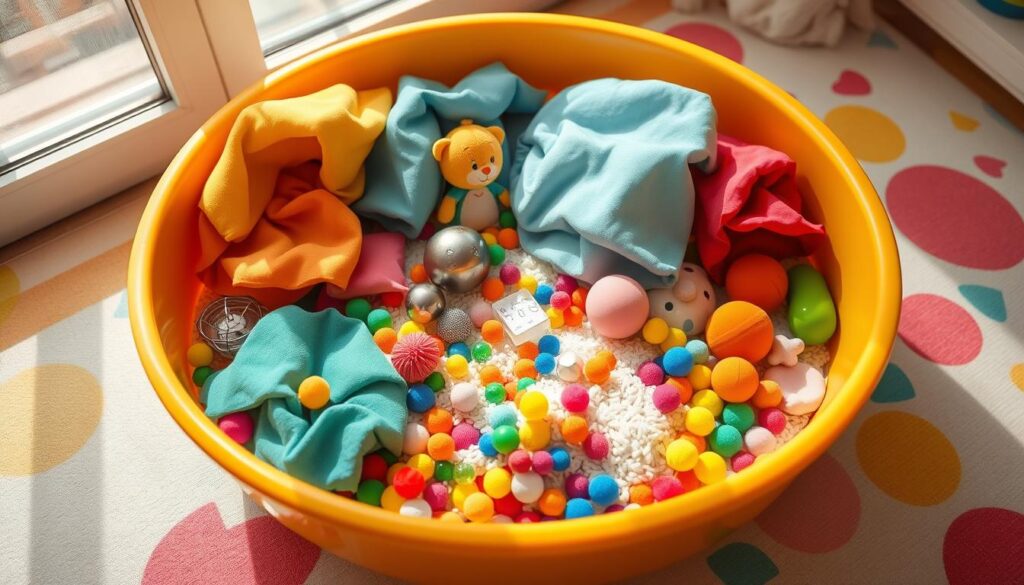
Sensory bins are awesome tools that captivate kids longer than most toys. They’re great for young ones to explore and discover. Making sensory bins for infants and toddlers is easy and really beneficial.
Sensory bins for babies are good to start at 12 months old. Some kids quickly get the hang of it. For example, a child started at 12 months and got good by 15 months. This shows how early sensory play makes a difference. Even kids of different ages can enjoy the same sensory activity board or bin together.
To make a great sensory bin, follow these steps:
- Select a Container: A 28qt storage container works well. For beginners, try using 2-3 lbs of dry rice.
- Choose Safe and Engaging Materials: You can use contrasting toys for babies or items like toy bugs for older kids.
- Set Clear Rules: Make rules like no dumping, no throwing, and no eating for safety and fun.
- Create Visual Boundaries: A blanket under the bin helps contain messes, making cleanup easier.
- Parental Involvement: Parents may need to guide play at first. If kids struggle with the rules, wait before trying again.
Thinking about how long kids play with sensory bins is key. Sensory bins for toddlers can entertain them for about 20 minutes. It’s crucial to be patient and adjust to their needs.
Diy sensory bins can be made cheaply with items like rice or beans. For example, lots of rice is about $5 and beans are near $6 for a few bags. These materials are affordable and effective.
In the end, sensory bins do more than occupy kids. They help with learning, feeling, socializing, and moving. By picking the right materials and setting rules, parents can make a safe, encouraging space for their kids to grow.
Interactive Sensory Games to Engage Young Minds
Interactive sensory games are key for early childhood development. They boost fine and gross motor skills, and spark cognitive growth and speech. The American Academy of Pediatrics says play improves physical skills in kids. Let’s look at easy-to-make sensory games for home fun.
Rock Band with Homemade Instruments
Turning household items into instruments is great for toddler play. DIY rock bands encourage creativity and hearing. For example, fill cans or jars with rice or beans to make maracas. Use pots and spoons for drums.
According to Bonglor, making instruments helps kids learn sounds and rhythms, important for hearing skills. It also promotes teamwork and social skills, ideal for group fun with kids.
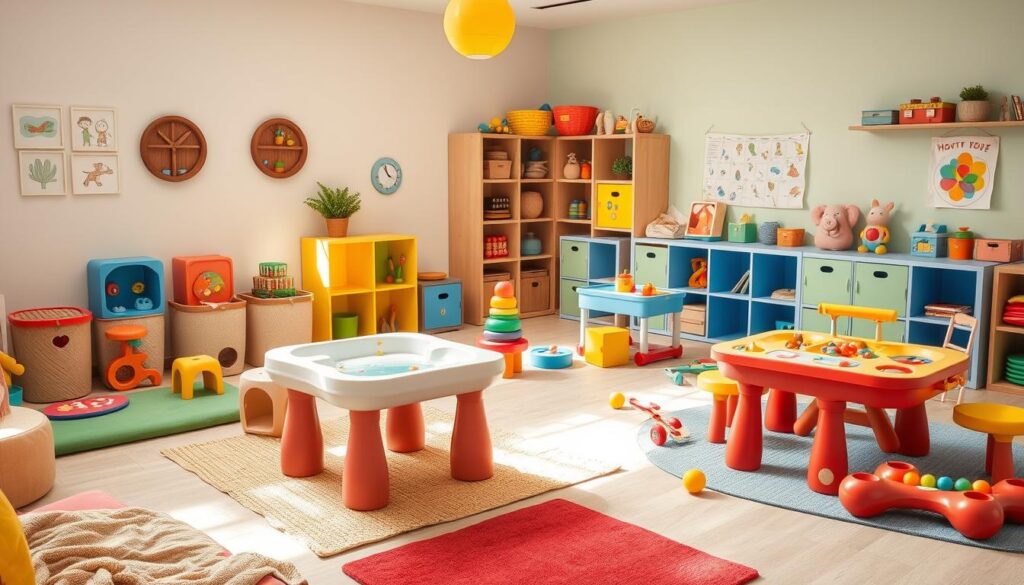
Homemade Drums Using Household Items
Making drums from home items offers another engaging game. Use oatmeal containers, plastic tubs, or coffee cans for drums. Change their covers with paper, foil, or plastic for different sounds.
The American Academy of Pediatrics notes DIY drums boost young kids’ fine motor skills and coordination. These sensory activities include touch and sound, key for cognitive and sensory growth. Making and playing drums also reduces stress, leading to a calm playtime.
DIY Sensory Play Ideas for Babies and Toddlers
Sensory play helps toddlers’ and babies’ brains grow. It’s vital for their learning. This part shows you how to make homemade sensory stuff for babies. By doing this, your little ones can explore their senses at home.
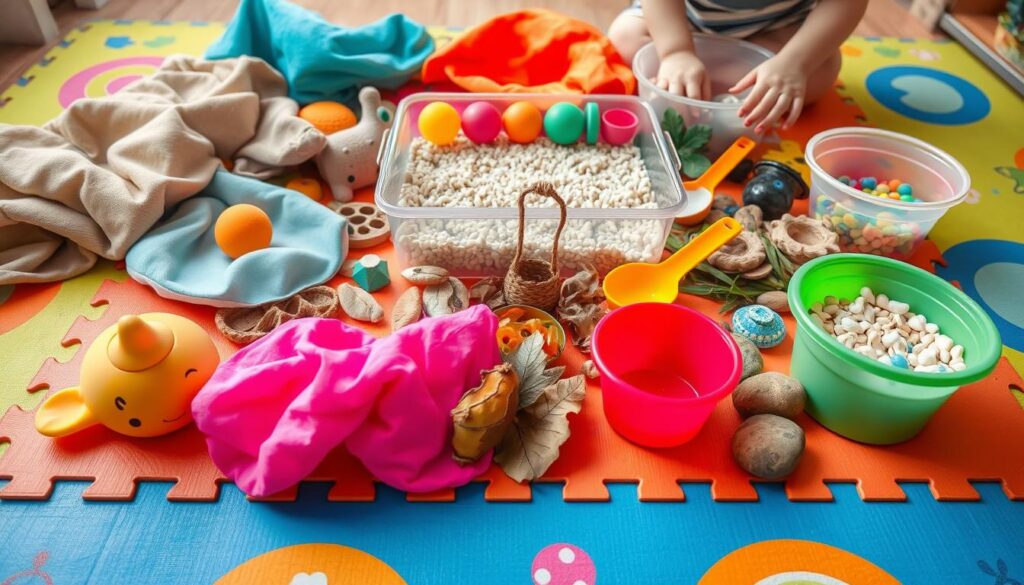
Making Homemade Finger Paint
Starting with finger paint is simple. Homemade finger paint is safe and brings joy to little ones. You just need cornstarch, water, and food coloring.
- Mix one part cornstarch with two parts water.
- Heat the mixture until it thickens, then let it cool.
- Divide into different bowls and add a few drops of food coloring to each.
These vibrant paints are great for touching and seeing. They make sensory play fun.
Building a Treasure Chest for Sensory Exploration
Next, put together a treasure chest. Fill it with various items like velcro, cotton balls, and fabrics. You can find these at home.
- Choose a container and decorate it with colorful paper or stickers.
- Fill it with items such as sponge bombs, baby-safe paintbrushes, and blocks for texture.
With these DIY ideas, babies can have lots of sensory fun. This treasure chest lets toddlers explore different textures and sounds.
20 Fun and Engaging Sensory Activities for Babies and Toddlers
Sensory play is key for kids’ growth. It involves activities that use their senses like touch and sight. Experts say the first years are very important for brain growth. By trying different sensory activities, kids get better at moving, thinking, and understanding the world.
There are many sensory activities for every kid. For example, a winter-themed bin is perfect for playtime inside when it’s cold. Fill a bin with rice, beans, or sand for a simple setup. It boosts creativity and lets kids explore. Sensory bottles are also great for play without screens. They use colors to help with visual skills.
Kids can play with things that are safe to eat, like oat bins or tapioca pearls. Cooking with kids lets them touch and taste different things. It’s fun and helps with their sensory skills. Adding games, walks, and indoor courses makes playtime even better. These activities ready kids for learning and making friends.

